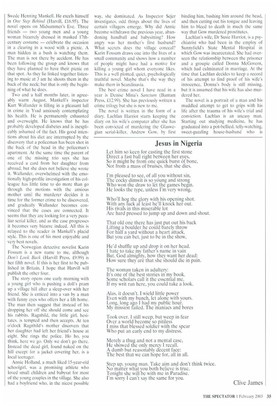Recent crime novels
Harriet Waugh
or the last few years Ruth Rendell has used her Chief Inspector Wexford detective novels to explore social issues that have been much in the papers. This has unfortunately made for unoriginal story lines with obvious villains in an all too familiar terrain.
It is a pleasure therefore to be able to report that The Babes in the Wood (Hutchinson, 116.99) returns to more traditional territory. The novel is set during the perpetual rain that we suffered last year. Kingsmarkham, the Sussex town where Wexford bestrides the police force, is in danger of flooding. The river having broken through its banks is threatening the environs of the town, which includes Wexford's home. From his sitting-room Wexford can see the creeping tide inching up the garden. His mind is only partially concerned with crime, the rest of it being mightily preoccupied with the ground floor of his home being submerged in water. Then a report comes in that a teenage brother and sister, together with their sitter, are missing. The hysterical mother is convinced that they have drowned while she has been away with her husband for a couple of daysholiday. This seems unlikely, since all three are excellent swimmers and the water didn't start to rise dramatically until after they had gone missing.
Wexford suspects that the female, exschool-teacher sitter has kidnapped or murdered them. But why? The children are bright, the parents ghastly, and the sitter turns out to be a curiously complex, not altogether likeable woman. The mother claims her as her best friend, but is considerably older. All this is excellent stuff and highly enjoyable.
Then, about half way through, there is a development of such a nature that it seemed obvious to me, although not to Wexford and his team, what has happened. From then onwards, the novel loses its impetus, as Wexford gradually works his way towards the reader's view of the matter. Only he doesn't. Unexpectedly he leaps lightly over the obvious conclusion, although the pattern is clearly discernible in the ending, and instead conjures a rabbit out of a hat and says in effect, 'This is what happened!' And very unlikely it is too.
A writer who makes the most histrionic scenarios seem phlegmatically likely is the Swede Henning Mankell. He excels himself in One Step Behind (Harvi11, £16.95). The novel opens on Midsummer's Eve. Three friends — two young men and a young woman bizarrely dressed in masked 17thcentury costume — celebrate the occasion in a clearing in a wood with a picnic. A man hidden in a bush is watching them. The man is not there by accident. He has been following the group and knows that they have planned to have their picnic on that spot. As they lie linked together listening to music at 3 am he shoots them in the back of the neck; but that is only the beginning of what he does.
Two and a half months later, in agreeably warm August, Mankell's inspector Kurt Wallander is filling in a pleasant lull in crime in Ysad anxiously contemplating his health. He is permanently exhausted and overweight. He knows that he has probably developed diabetes and is inexplicably ashamed of the fact. His good intentions about his diet are interrupted by the discovery that a policeman has been shot in the back of the head in the policeman's apartment. Al the same time the parent of one of the missing trio says she has received a card from her daughter from abroad, hut she does not believe she wrote it. WaBander, overwhelmed with the emotionally high-profile investigation of his colleague has little time to do more than go through the motions with the anxious mother until the murderer decides it is time for the former crime to be discovered, and gradually Wai'Lander becomes convinced that the cases are connected. It seems that they are looking for a very peculiar serial killer, and as the case progresses it becomes very bizarre indeed. All this is relayed to the reader in Mankell's placid style. This is one of his most enjoyable and very best novels,
The Norwegian detective novelist Karin Fossum is a new name to me, although Don't Look Back (Harvill Press, £9.99) is her fifth novel. If this is her first to be published in Britain, I hope that Harvill will publish the other four.
The story opens one early morning with a young girt who is pushing a doll's pram up a village hill after a sleep-over with her friend. She is enticed into a van by a man with funny eyes who offers her a lift home. The man then suggest that instead of his dropping her off she should come and see his rabbits. Ragnhild, the little girl, hesitates, is tempted and then accepts. At ten o'clock Ragnhild's mother discovers that her daughter had left her friend's house at eight. She rings the police. Ho ho, you think, here we go. Only we don't go there. Instead the dead girl, found naked on the hill except for a jacket covering her, is a local teenager.
Annie Holland, a much liked 15-year-old schoolgirl, was a promising athlete who loved small children and babysat for most of the young couples in the village. She also had a boyfriend who, in the nicest possible way, she dominated. As Inspector Sejer investigates, odd things about the lives of certain villagers emerge. Why did Annie become withdrawn the previous year, abandoning handball and babysitting? How angry was her mother's first husband? What secrets does the village conceal? Karin Fossum draws one into the lives of a small community and shows how a number of people might have had a motive for killing a young girl whom everyone likes. This is a well plotted, quiet, psychologically truthful novel. Maybe that's the way they make them in Scandinavia.
The best crime novel I have read in a year is Denise Mina's Sanctum (Bantam Press, £12.99), She has previously written a crime trilogy but she is new to me.
The novel is written in the form of a diary. Lachlan Harriot starts keeping the diary on his wife's computer after she has been convicted of murdering the Glaswegian serial-killer, Andrew Gow, by first binding him, bashing him around the head, and then cutting out his tongue and leaving him to bleed to death in much the same way that Gow murdered prostitutes.
Lachlan's wife, Dr Susie Harriot, is a psychiatrist who had been in the employ of Sunnyfield's State Mental Hospital in which Gow was incarcerated. She had overseen the relationship between the prisoner and a groupie called Donna McGovern, which had culminated in marriage. At the time that Lachlan decides to keep a record of his attempt to find proof of his wife's innocence, Donna's body is still missing, but it is assumed that his wife has also murdered her.
The novel is a portrait of a man and his muddled attempt to get to grips with his life after the trauma of his wife's trial and conviction. Lachlan is an uneasy man. Starting out studying medicine, he has graduated into a pot-bellied, telly-watching, sweet-guzzling house-husband who is devoted to his little girl and is devastated by feelings of loss at Susie's absence. Despite holding two or three conflicting views at once about everything that has happened he gradually manages to draw back the veil from his marriage, his wife, and even himself, and slowly work out the intricacies of a very involved crime with completely unforeseeable results.
Sanctum is an excellent detective novel that keeps you wondering to its satisfactory conclusion. I have sometimes thought that women's fiction, with some exceptions, often shows a certain weakness in portraying men. Denise Mina's portrait of Lachlan Harriot is one of the exceptions.




























































 Previous page
Previous page